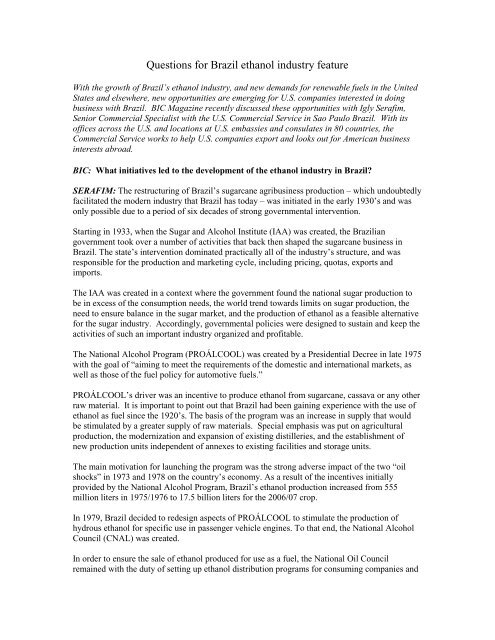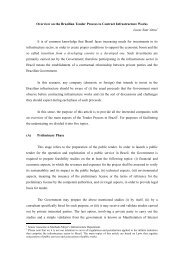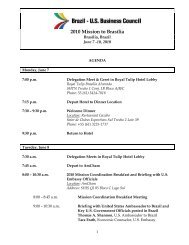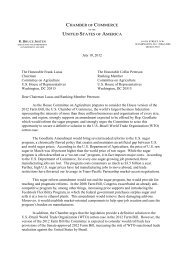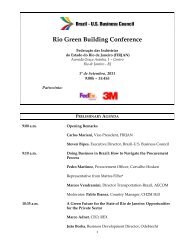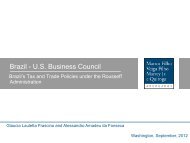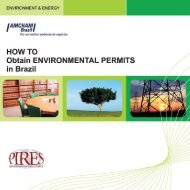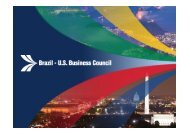Questions for Brazil ethanol industry feature - Brazil-US Business ...
Questions for Brazil ethanol industry feature - Brazil-US Business ...
Questions for Brazil ethanol industry feature - Brazil-US Business ...
Create successful ePaper yourself
Turn your PDF publications into a flip-book with our unique Google optimized e-Paper software.
<strong>Questions</strong> <strong>for</strong> <strong>Brazil</strong> <strong>ethanol</strong> <strong>industry</strong> <strong>feature</strong>With the growth of <strong>Brazil</strong>’s <strong>ethanol</strong> <strong>industry</strong>, and new demands <strong>for</strong> renewable fuels in the UnitedStates and elsewhere, new opportunities are emerging <strong>for</strong> U.S. companies interested in doingbusiness with <strong>Brazil</strong>. BIC Magazine recently discussed these opportunities with Igly Serafim,Senior Commercial Specialist with the U.S. Commercial Service in Sao Paulo <strong>Brazil</strong>. With itsoffices across the U.S. and locations at U.S. embassies and consulates in 80 countries, theCommercial Service works to help U.S. companies export and looks out <strong>for</strong> American businessinterests abroad.BIC: What initiatives led to the development of the <strong>ethanol</strong> <strong>industry</strong> in <strong>Brazil</strong>?SERAFIM: The restructuring of <strong>Brazil</strong>’s sugarcane agribusiness production – which undoubtedlyfacilitated the modern <strong>industry</strong> that <strong>Brazil</strong> has today – was initiated in the early 1930’s and wasonly possible due to a period of six decades of strong governmental intervention.Starting in 1933, when the Sugar and Alcohol Institute (IAA) was created, the <strong>Brazil</strong>iangovernment took over a number of activities that back then shaped the sugarcane business in<strong>Brazil</strong>. The state’s intervention dominated practically all of the <strong>industry</strong>’s structure, and wasresponsible <strong>for</strong> the production and marketing cycle, including pricing, quotas, exports andimports.The IAA was created in a context where the government found the national sugar production tobe in excess of the consumption needs, the world trend towards limits on sugar production, theneed to ensure balance in the sugar market, and the production of <strong>ethanol</strong> as a feasible alternative<strong>for</strong> the sugar <strong>industry</strong>. Accordingly, governmental policies were designed to sustain and keep theactivities of such an important <strong>industry</strong> organized and profitable.The National Alcohol Program (PROÁLCOOL) was created by a Presidential Decree in late 1975with the goal of “aiming to meet the requirements of the domestic and international markets, aswell as those of the fuel policy <strong>for</strong> automotive fuels.”PROÁLCOOL’s driver was an incentive to produce <strong>ethanol</strong> from sugarcane, cassava or any otherraw material. It is important to point out that <strong>Brazil</strong> had been gaining experience with the use of<strong>ethanol</strong> as fuel since the 1920’s. The basis of the program was an increase in supply that wouldbe stimulated by a greater supply of raw materials. Special emphasis was put on agriculturalproduction, the modernization and expansion of existing distilleries, and the establishment ofnew production units independent of annexes to existing facilities and storage units.The main motivation <strong>for</strong> launching the program was the strong adverse impact of the two “oilshocks” in 1973 and 1978 on the country’s economy. As a result of the incentives initiallyprovided by the National Alcohol Program, <strong>Brazil</strong>’s <strong>ethanol</strong> production increased from 555million liters in 1975/1976 to 17.5 billion liters <strong>for</strong> the 2006/07 crop.In 1979, <strong>Brazil</strong> decided to redesign aspects of PROÁLCOOL to stimulate the production ofhydrous <strong>ethanol</strong> <strong>for</strong> specific use in passenger vehicle engines. To that end, the National AlcoholCouncil (CNAL) was created.In order to ensure the sale of <strong>ethanol</strong> produced <strong>for</strong> use as a fuel, the National Oil Councilremained with the duty of setting up <strong>ethanol</strong> distribution programs <strong>for</strong> consuming companies and
oil distributors, whereas the prices of fuel <strong>ethanol</strong> were proposed by the National Oil Council andset by the National Alcohol Council. The <strong>Brazil</strong>ian government also set up rules <strong>for</strong> thetransportation, marketing and storage of fuel <strong>ethanol</strong>.<strong>Brazil</strong>’s action on the national sugarcane agribusiness activities could not be maintainedindefinitely, and the reduction of state action proceeded quickly. This started with the release ofthe <strong>industry</strong>’s products <strong>for</strong> export in 1989, and price releases <strong>for</strong> several types of sugar and alsoanhydrous <strong>ethanol</strong>, and ended with the release of those prices still under official control, i.e.sugarcane, standard sugar and hydrous <strong>ethanol</strong> prices, in 1999.In 2003, flex fuel vehicles (FFV) were introduced in the <strong>Brazil</strong>ian market. These vehicles aredesigned to be fueled with gasoline, <strong>ethanol</strong>, or any blend of gasoline and <strong>ethanol</strong>.On April 28th, 2011, President Dilma Rouseff signed Provisional Measure (Medida Provisoria –MP) #532 which lowers from 20 to 18 percent the minimum volume of <strong>ethanol</strong> required to blendwith gasoline. The new blend range varies from 18 and 25 percent. The current blend has been setat the cap (25 percent) since May 1, 2010. However, the Government of <strong>Brazil</strong> (GOB) has studiedthe possibility to reduce it to 18 percent due to the expected shortage in <strong>ethanol</strong> supply, aconsequence of the drop in the size of the sugarcane crop.In addition, MP #532 of April 28th, 2011, changes the status of <strong>ethanol</strong> from that of agri-businesscommodity to national strategic energy resource. The measure delegates greater authority to theNational Agency of Petroleum, Natural Gas and Biofuels (ANP) to regulate the <strong>ethanol</strong> supplychain. ANP will now expand beyond its traditional role of monitoring <strong>ethanol</strong> distribution oncethe product left the mill headed to the pump; the agency will oversee <strong>ethanol</strong> production insidemills – until recently the mandate of the Ministry of Agriculture (MAPA).Several measures are currently under discussion and are likely to be adopted by ANP in the nearfuture, including: (1) the introduction of 2-year contracts between <strong>ethanol</strong> suppliers and fueldistributors and, (2) a mandatory 8 percent minimum carryover stocks on March 1 to be held byproducers to guarantee <strong>ethanol</strong> supply. If domestic supply is not available at the time, that will<strong>for</strong>ce <strong>ethanol</strong> producers to import the product to comply with the measure.BIC: What portion of the nation’s energy consumption is composed of biofuels?SERAFIM: <strong>Brazil</strong> is a global leader in the use of renewable fuels. Indeed, the Ministry of Minesand Energy (MME) has set the increase of biofuels’ share in the <strong>Brazil</strong>ian energy matrix as one ofthe policy directives <strong>for</strong> the sector.In June 2011, the Ministry of Mines and Energy released the Energy Expansion Decennial Plan2011/2020 (PDE-2020) <strong>for</strong> public consultation. According to the plan, the share of renewablesources (hydroelectric, <strong>ethanol</strong>, biomass, etc.) in the <strong>Brazil</strong>ian energy matrix is expected toincrease to 46.3 percent in 2020, up 1.5 points compared to 44.8 percent in 2010.The study also projects that <strong>ethanol</strong> demand <strong>for</strong> both the domestic market and exports shouldincrease to 73 billion liters in 2020.<strong>Brazil</strong> remains an important user of <strong>ethanol</strong> <strong>for</strong> fuel consumption. Total domestic demand <strong>for</strong><strong>ethanol</strong> <strong>for</strong> calendar year 2012 is <strong>for</strong>ecast at 25.05 billion liters, up 2.85 billion liters from 2011consumption (22.195 billion liters), based on likely more attractive <strong>ethanol</strong> prices at the pumpcompared to 2011 and the steady sales of flex-fuel vehicles in the market. Total <strong>ethanol</strong>
consumption <strong>for</strong> use as fuel is estimated at 22.5 billion liters <strong>for</strong> 2012. Ethanol consumption <strong>for</strong>other uses is projected at 2.55 billion liters, up 200 million from 2011 due to steady demand fromthe chemical industries.The size of the <strong>Brazil</strong>ian light vehicle fleet is roughly estimated at 28 million units and purehydrous <strong>ethanol</strong> and flex fuel powered vehicles represent together approximately 50 percent ofthe total fleet. Industry projections report that the share of flex fuel vehicles is likely to reach 86percent by 2020.The use of <strong>ethanol</strong> as a fuel in <strong>Brazil</strong> reached 19.1 million cubic meters in 2011. <strong>Brazil</strong>iangasoline contains between 20 and 25% of <strong>ethanol</strong>.BIC: What are the latest technological advances in <strong>ethanol</strong> production?SERAFIM: In addition to actions aimed at a strong dissemination of technologies that arealready commercially available, innovation in <strong>ethanol</strong> production processes and productdiversification (from sucrose and lignocellulosic sugar-cane waste) are going to take place.New technologies <strong>for</strong> <strong>ethanol</strong> production are under development such as: improvement ofprocesses <strong>for</strong> water saving, increase in <strong>ethanol</strong> production efficiency, improvement of processes<strong>for</strong> energy cogeneration, development of new processes based on <strong>ethanol</strong> chemistry andsugarcane biomass development, improvement of motors and turbines <strong>for</strong> maximization of energyefficiency in the use carburant <strong>ethanol</strong>.The genetic modification of sugarcane is advancing very fast in <strong>Brazil</strong> both on an experimentalscale and in field-testing. For example, the sugarcane genome was originally mapped in 2001 inSao Paulo, and dozens of projects that also address functional genomes are being developed byboth public and private institutions.Product diversification is being expanded to include sucrose products and <strong>ethanol</strong> chemistry, as isan increase in energy production from the sugarcane biomass. Excluding sucrose, the energycontained in one metric ton of sugarcane (including the straw) is equivalent to 2/3 of the energycontained in an oil barrel. That biomass can be recovered at relatively low costs, and less thanhalf of it is used today. Available technologies can generate additional electric powercorresponding to 30 percent more than the sugar and <strong>ethanol</strong> sale price using the bagasse and 50percent of the straw. The development of an efficient conversion of biomass into <strong>ethanol</strong>(expected <strong>for</strong> the next 10 years) could lead to an equal additional sale value.BIC: What are the prospects <strong>for</strong> cooperation between the United States and <strong>Brazil</strong>with regard to <strong>ethanol</strong>?SERAFIM: The United States and <strong>Brazil</strong> have signed a Memorandum of Understanding onbiofuel cooperation. The two nations pledged closer cooperation on researching alternativeenergy production, promoting alternative fuels in the region and developing <strong>industry</strong> widestandards and codes that could lay the groundwork <strong>for</strong> a global biofuels market. Steps are alreadybeing taken to cooperate on harmonization of <strong>ethanol</strong> markets, trans<strong>for</strong>ming the biofuel into acommodity and developing partnerships in technology.
Looking to Export? The U.S. Commercial Service Can HelpU.S. energy and industrial service companies pursuing business opportunities in <strong>Brazil</strong> canbenefit from the services of the U.S. Commercial Service. With its network of offices across theU.S. and in more than 80 countries, the U.S. Commercial Service of the U.S. Department ofCommerce utilizes its global presence and international marketing expertise to help U.S.companies sell their products and services worldwide:<strong>Business</strong> counseling and customized market research to fit a firm’s specific needs.The Gold Key Service that arranges pre-screened meetings with potential overseasbusiness partners and government agencies, tailored to U.S. companies’ needs.International Company Profile that provides due diligence and background checks onpotential overseas business partners.Customized contact lists of potential partners and key <strong>for</strong>eign government agencies tohelp you make those key connections.The Commercial Service also anchors a Commerce Energy Team with expertise in powergeneration, renewable energies, coal, and oil and gas. For the latest energy trade leads,visit www.buyusa.gov/eme/Foreign companies such as those in <strong>Brazil</strong> can also benefit from Commercial Service partneringprograms as well to source products and services from U.S. companies.The U.S. Commercial Service in <strong>Brazil</strong> has four offices—in Rio de Janeiro, São Paulo, BeloHorizonte and Brasila. This includes nine U.S. commercial officers and over 50 <strong>Brazil</strong>ian staffmembers, who are based in <strong>Brazil</strong> and are fluent in both English and Portuguese. Many of ourstaff have many years of sector-specific experience with the private sector and with <strong>Brazil</strong>iangovernment entities. For more in<strong>for</strong>mation, contact the nearest Commercial Service U.S. ExportAssistance Center at www.export.gov or visit www.buyusa.gov/<strong>Brazil</strong>.gov###


